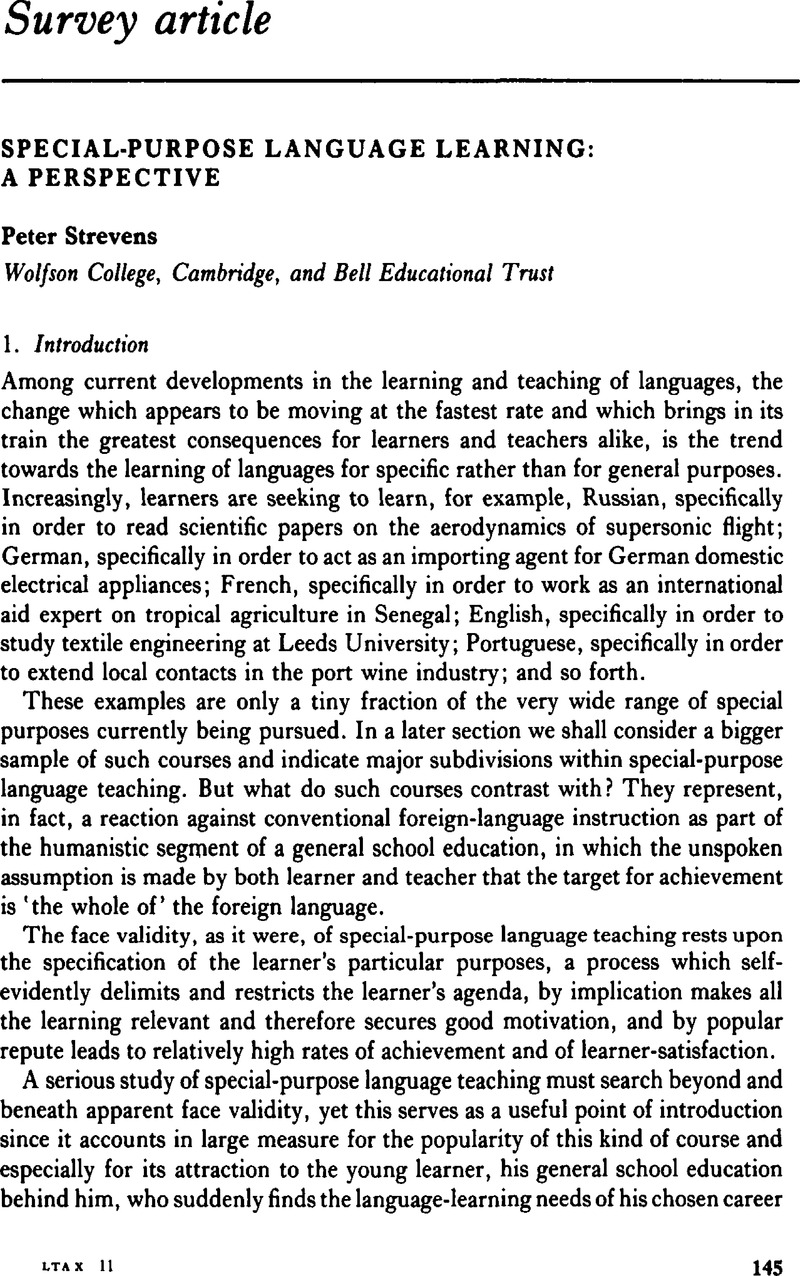Crossref Citations
This article has been cited by the following publications. This list is generated based on data provided by Crossref.
Ulijn, Jan
1980.
Foreign language reading research: recent trends and future propects.
Journal of Research in Reading,
Vol. 3,
Issue. 1,
p.
17.
Johns, Ann M.
1980.
Cohesion in written business discourse: Some contrasts.
The ESP Journal,
Vol. 1,
Issue. 1,
p.
35.
Johns, Ann M.
1981.
ESP: English for specific purposes.
The ESP Journal,
Vol. 1,
Issue. 2,
p.
163.
Mackay, Ronald
1981.
Accountability in ESP programs.
The ESP Journal,
Vol. 1,
Issue. 2,
p.
107.
Coffey, Bernard
1984.
ESP – English for Specific Purposes.
Language Teaching,
Vol. 17,
Issue. 1,
p.
2.
1989.
Working with Language.
p.
573.
Fanning, Paul
1993.
Broadening the ESP umbrella.
English for Specific Purposes,
Vol. 12,
Issue. 2,
p.
159.
Biria, Reza
and
Tahririan, M.Hassan
1994.
The methodology factor in teaching ESP.
English for Specific Purposes,
Vol. 13,
Issue. 1,
p.
93.
West, Richard
1994.
Needs analysis in language teaching.
Language Teaching,
Vol. 27,
Issue. 1,
p.
1.
Lowe, Ivan
1996.
Non-verbal devices in pre-university science: The extent of correspondence between English and French.
English for Specific Purposes,
Vol. 15,
Issue. 3,
p.
217.
O'toole, Mitch
1996.
Science, Schools, Children and Books: Exploring the Classroom Interface between Science and Language.
Studies in Science Education,
Vol. 28,
Issue. 1,
p.
113.
Burnaby, Barbara
1997.
Encyclopedia of Language and Education.
p.
95.
Johns, Ann
2001.
Hedging in scientific research articles.
English for Specific Purposes,
Vol. 20,
Issue. 2,
p.
200.
Neff Van Aertselaer, Jo Anne
2006.
A RHETORICAL ANALYSIS APPROACH TO ENGLISH FOR ACADEMIC PURPOSES.
Revista de Lingüística y Lenguas Aplicadas,
Vol. 1,
Issue. 1,
Ashuja'a, Abdulhameed
2011.
Current developments in English for academic and specific purposes in developing, emerging and least-developed countries.
Journal of English for Academic Purposes,
Vol. 10,
Issue. 3,
p.
200.
Cameron, Carrie
Chang, Shine
and
Pagel, Walter
2011.
Scientific English: A Program for Addressing Linguistic Barriers of International Research Trainees in the United States.
Journal of Cancer Education,
Vol. 26,
Issue. 1,
p.
72.
Starfield, Sue
2012.
The Encyclopedia of Applied Linguistics.
Chou, Chuing Prudence
and
Ching, Gregory
2012.
Taiwan Education at the Crossroad.
p.
89.
Ghahremani-Ghajar, Sue-san
Mohammadi Doostdar, Hossein
and
Mirhosseini, Seyyed-Abdolhamid
2012.
We have been living with this pain: enquiry-based language learning in Iranian higher education.
Teaching in Higher Education,
Vol. 17,
Issue. 3,
p.
269.
Ching, Gregory S
2012.
Blog assisted learning: Experiences in learning Business English vocabularies.
International Journal of Research Studies in Educational Technology,
Vol. 1,
Issue. 1,



